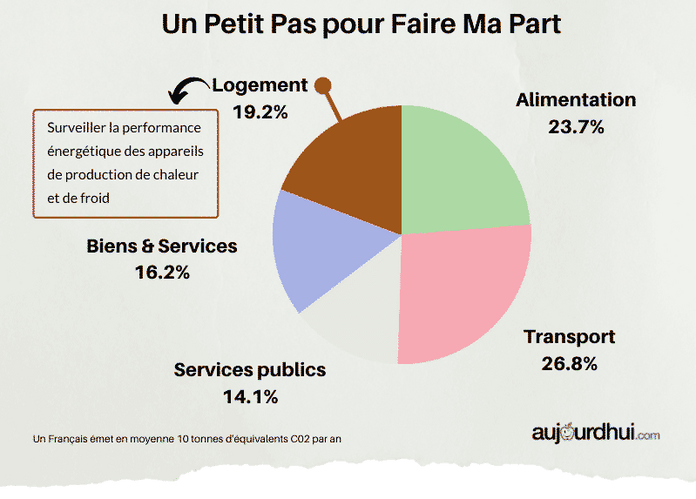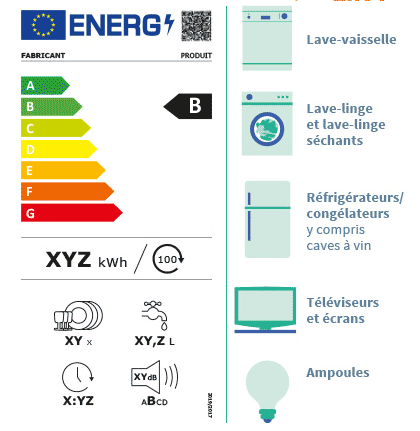In this period of dizzying increase in prices, we must base ourselves on the obvious: the cheapest (and most ecological) electricity is the one that we do not consume. So how to reduce electricity consumption? Here are 10 smart tips to lighten your next bills!
The cheapest (and greenest) electricity is the one you don’t use. If each of us significantly reduced our electricity consumption, we would need it less and we could produce less…
Washing machine, light bulbs, toaster, but also telephone, computer, television, printer… All the devices that make our comfortable life are hungry for electricity.
One small step to do your part
I prefer to warn you, energy savings on your electrical appliances will not have a decisive impact on your carbon footprint. Why ?
As electricity production is largely decarbonized in France (70% nuclear + 20% renewable energies), it is difficult to significantly reduce your CO2 emissions through more reasonable use of household appliances or the lighting system. On the other hand, given thefrightening increase in the price of electricityconsuming less and consuming it better makes a lot of sense.
I make you 3 hints which can be valuable to you:
- At home, you must especially control the consumption and the setting of the heat generating devices such as the electric hot water tank or electric radiators, but also the washing machine and the dryer.
- Similarly, one must monitor the cold production devices such as the refrigerator, the freezer or, if you have one, an appliance that combines the two.
- The good reference if you are replacing an electrical appliance is theenergy label graduated from A to G (for televisions, refrigerators, washing machines, lamps, etc.). Although they may be more expensive to purchase, class A and B appliances, which are energy-optimized, are largely amortized after a few years of use.
If you want to do your partand achieve energy savings (and savings in short), you must above all concentrate on the adjustment and operation of the devices that produce heat and cold. The rest often only has a marginal impact.
If you lower your heating thermostat by 1°C in winter, you’ll save 7%! And if you absolutely have to replace an irreparable device, trust the energy and environmental labelseven if it means paying a little more.

electrical appliances
Admittedly, some work on batteries (like telephones) and are therefore less thirsty for energy, but for reduce electricity consumptionwe must watch the others closely, and in particular those who remain permanently connected to the outlets…
Here is a few simple gestures to reduce its electricity consumption and reduce its bills!
1. Unplug
First you have to do the hunt for red lights who report the standby devices and which can represent up to 10% of the electricity bill. Computers, screens, TVs, printers must be completely turned off, by unplugging them when they are not in use (especially at night).
If left plugged in, the phone charger continue to consume electricity, even if there is no telephone at the end of the cable!
2. Look for the label
When you buy any electrical device, you have to get into the habit of relying on theeuropean energy label which guarantees that the products are energy efficient. Attention should also be paid to environmental labels that point out the most environmentally friendly products and services, those that are repairable or recyclable and those which may contain hazardous components for health.

3. Switch off
Studies have estimated electricity consumption at more than 10% devoted to lighting in accommodation in France. To reduce your electricity consumption, you must start by systematically turning off the light when you leave a room. This is the basis !
4. Wait until it’s full!
Half-loading the washing machine uses less water but just as much electricity! Rather wait for the drum to your washing machine is full to “launch a machine”. This is also true for the dishwasher.
Use the “Eco” program to save water and energy. Even if the cycle time is longer and the washing time is longer, the water is less heated. This is what consumes the most electricity.
light and water
4. Trust the sun
You can also use natural light (as much as possible) by installing your desktop computer near the windows to work. Same thing for your favorite chair when you want to read.
And for the coating or painting of the walls of your living rooms, choose light colors that go reflect light. Small electricity savings start like this.
5. LEDs to reduce electricity consumption
At the lighting level, the LED bulbs today represent the most economical, most ecological and healthiest solution. Less expensive than halogen or energy-saving bulbs, they are also less energy intensive. In addition, they do not contain mercury (which facilitates their recycling) and light up instantly.
6. Save hot water
By avoiding wasting hot water, you save electricity! No need to leave the cold/hot tap water mixer tap in an intermediate positionbecause this uses every time.
To wash your hands, clean your fruits and vegetables or rinse your sponge, cold water is enough. Also remember to equip your taps with a flow reducer, this will reduce your water bill…
7. Adjust your hot water tank
Program the temperature of your hot water tank between 50℃ and 60℃, this is sufficient to limit the development of pathogenic bacteria. It’s a small gesture more to reduce its electricity consumption devoted to heating water.
Heating and air conditioning
9. Avoid electric heating
Heating is, in general, the largest share of energy consumption housing. You must favor sobriety, by limiting energy waste, and efficiency, by choosing the devices most suited to your real needs.
electric heaters waste a lot of energy and are expensive to use: they should only be used for auxiliary heating in well-insulated rooms. You can use reflective panels behind the radiators: they will reflect the heat better.
To heat yourself, choose a heating method based on renewable energy as much as possible (wood, solar, etc.) or consider installing a heat pump. It will take a little heat from a cold source (in the ground of the garden, the surrounding air or the water of a tablecloth), increase its temperature and restore heat in the housing. ADEME has designed a free practical guide on the subject.
10. Forget the air conditioning
Air conditioners are devices horribly energy-intensive. On average, for use of about 4 hours a day, the electricity bill increases by about 15% on the month. Beyond that, the increase will be around 20 to 25%.
When the temperature is high in summer, hang a damp sheet at the window. The passage of heat will create natural evaporation capable of cooling the room.
It is with small gesturesof the anticipatory strategies (especially when buying new equipment) and habit changes (modest but impactful) that we succeed, in the long run, in reducing our electricity consumption!


















